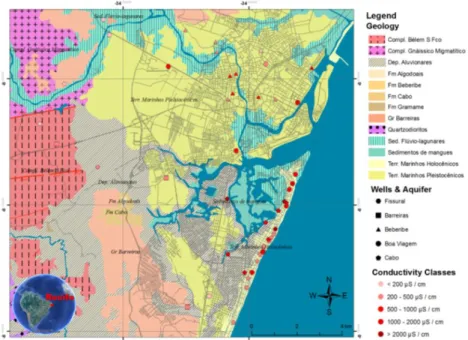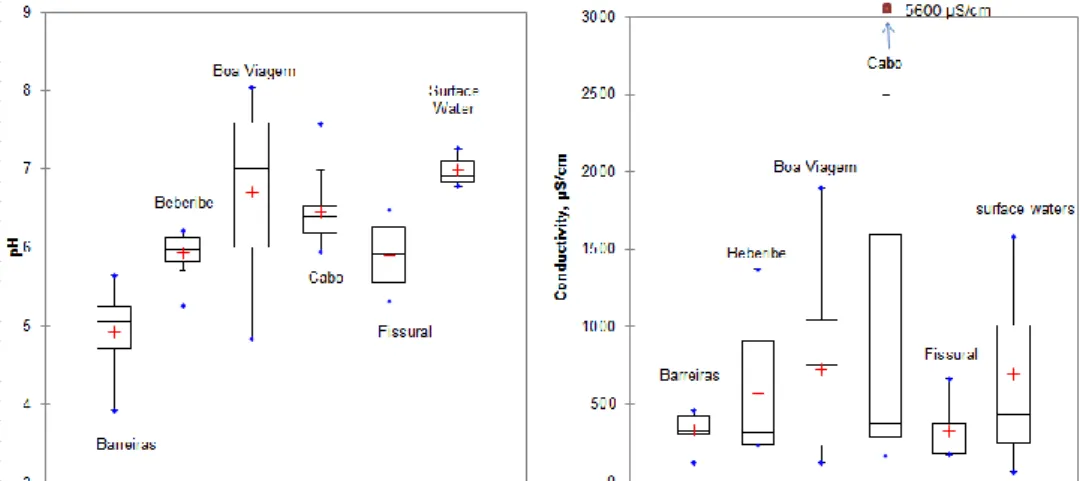HAL Id: hal-00772976
https://hal-brgm.archives-ouvertes.fr/hal-00772976
Submitted on 11 Jan 2013
HAL is a multi-disciplinary open access
archive for the deposit and dissemination of
sci-entific research documents, whether they are
pub-lished or not. The documents may come from
teaching and research institutions in France or
abroad, or from public or private research centers.
L’archive ouverte pluridisciplinaire HAL, est
destinée au dépôt et à la diffusion de documents
scientifiques de niveau recherche, publiés ou non,
émanant des établissements d’enseignement et de
recherche français ou étrangers, des laboratoires
publics ou privés.
Groundwater salinization in a coastal multilayer aquifer:
Preliminary results on origins and mechanisms.
Example of Recife (Brazil)
Lise Cary, Emmanuelle Petelet-Giraud, Suzana Maria Gico Lima Montenegro,
Ricardo Hirata, Veridiana Martins, Axel Aurouet, Hélène Pauwels, Wolfram
Kloppmann, Luc Aquilina
To cite this version:
Lise Cary, Emmanuelle Petelet-Giraud, Suzana Maria Gico Lima Montenegro, Ricardo Hirata,
Verid-iana Martins, et al.. Groundwater salinization in a coastal multilayer aquifer: Preliminary results
on origins and mechanisms. Example of Recife (Brazil). 14th International Symposium on
Water-Rock Interaction, WRI 14, Jun 2013, Avignon, France. pp.118-122, �10.1016/j.proeps.2013.03.164�.
�hal-00772976�
Water Rock Interaction [WRI 14]
Groundwater salinization in a coastal multilayer aquifer:
Preliminary results on origins and mechanisms. Example of
Recife (Brazil)
Lise Cary
a1, Emmanuelle Petelet-Giraud
a, Suzana Montenegro
b, Ricardo Hirata
c,
Veridiana Martins
c, Axel Aurouet
d, Hélène Pauwels
a, Wolfram Kloppmann
a, Luc
Aquilina
eand the COQUEIRAL team
a BRGM, 3 Avenue Claude Guillemin, 45060 Orléans Cedex 2, France bUFPE, Civil Engineering Department, 50740 Recife, Brazil
c USP, Instituto de Geociências - Rua do Lago, 562 ; Butantã - 05508-080 Sao Paulo, Brazil dGeoHyd, 101 rue Jacques Charles, 45160 Olivet, France
eCAREN Univ. Rennes 1 - Campus de Beaulieu - a. du Gal Leclerc, Bâtiment 15B, 35042 Rennes, France
Abstract
The Recife Metropolitan Region (PE, Brazil) appears as a typical "hot spot" illustrating the problems of southern countries such as urbanization or rapid industrial and touristic development. All these factors induce high pressures on water resources both on quantity and quality in the context of global social and environmental changes. This paper focuses on the groundwater geochemistry in a costal multilayer aquifer aiming at investigating the sources and processes of salinization. The preliminary results of 62 groundwater samples from the five main aquifers are reported.
Keywords: Groundwater; salinization; Water–rock interactions
1. Introduction
Due to an increasing demographic pressure, the Metropolitan Region of Recife (RMR) composed of 14 cities went through remarkable changes of water and land uses over the last decades. These evolutions gave rise to numerous environmental consequences, such as a dramatic decline of the piezometric levels, groundwater salinization and contamination. This degradation of natural resources is linked to the increase of water demand, punctually amplified by drought periods which induced the construction of thousands of private wells, hindering global political solutions. Under these conditions, an interdisciplinary research program aiming to study the human impact on coastal overexploited aquifers is proposed through three main converging axes: (1) the analysis of pressures on the groundwater resources and their societal and structural reasons, (2) the identification of sources and mechanisms of groundwater quality and quantity degradation, focusing on the physical and chemical processes as vectors of the reaction of the system to the external pressures, and (3) the assessment of the regional impact of global changes on water resources. One of the objectives is to determine the origin and processes of salinization, including a multi-tracer approach, to identify sources and pathways of inorganic contamination and to determine the residence time of water within the aquifer system. Finally, and based on the gained knowledge, hydrogeological conceptual and 3D numerical models of the functioning of the aquifer system in its social and environmental contexts will be developed.
2. Geological and Hydrological context
Recife was built on the estuarine area of the Capibaribe River and other small rivers, with a net of canals and bridges above rivers. The Recife coastal plain is located in the geographic limits of the sedimentary basins of Cabo and Pernambuco-Paraíba which consist out of fluvial and marine geologic formations. It is composed of three main aquifers: the two semi-confined Cabo and Beberibe aquifers, both underlining the superficial Boa Viagem unconfined aquifer, which is the most directly exposed to contamination, since it is connected to
* Corresponding author. Tel.: +33238643260; fax: +33238643446.
mangroves, rivers, estuaries and highly urbanized areas [1]. The Boa Viagem aquifer is made of marine terraces of sand, silt and clay has an average thickness of 40 m. The Cabo aquifer occurs in the south of Recife and comprises sandstones, siltstones and mudstones, with an average thickness of 90 m. The Beberibe aquifer occurs in the north and central area of Recife with an average thickness of 100 m of sandstones with intercalations of mudstone; it is the most important one, with the highest amount of good quality water even if few wells already show salinity. Both the Beberibe and Cabo aquifers contain large clay levels. The hydraulic connections between the three aquifers are not well known but isotopic studies have shown that the recharge processes are similar, suggesting that exchanges may occur and may be modified or amplified by overexploitation [2] especially between the Cabo and Boa Viagem aquifers [3]. Due to high depletion in groundwater levels reaching more than 2 m per year between 1992 and 2006 [4] and increasing salt content since the 1970s, many wells are not used anymore. Numerical modeling has shown that Beberibe and Cabo aquifers are being exploited well beyond the limits of natural recharge [5, 6]. Two other aquifers can be found west of the city: the Barreiras aquifer, characterized by alternating well stratified layers, is coated at its edges by the Boa Viagem aquifer. Mostly underlying the Beberibe and Barreiras aquifers with some outcrops, the Fissural aquifer is composed of basement rocks (granites/migmatites) with low storage capacity.
3. Groundwater salinization
Large knowledge gaps persist on the relative importance of different potential mechanisms of salinization in the RMR. Indeed, salinization can result from direct seawater intrusion into the overexploited aquifer but also brackish water inflow from mangrove swamps and the estuarine zone as well as the upwelling of ancient seawater [7]. Vertical exchanges between the aquifers can be triggered by wellhead drawdown in the shallow Boa Viagem aquifer, and/or through failed or improperly constructed wells. In these conditions, remediation measures can only be proposed when the sources and pathways of salinization are elucidated. In order to track sources of salinization, a multi-isotopic fingerprinting approach of the water system is developed (δ18O, δ2H,
87Sr/86Sr, δ11B, δ34S-SO4, δ18O-SO4). Chemical parameters (Cl, Br, B, SO4, major and trace cations) and tracers
will help to (1) better constrain water circulations, (2) elucidate the origins and processes of salinization, but also to (3) locate and trace specific pollution sources (e.g. sewage, industrial and urban point-contaminations) that impact the aquifer. The sampling strategy was built at the RMR scale on the preexisting knowledge of the RMR aquifers and quality based on HYDROREC I and II database [4, 8] and on recent studies [9]. Typologies were
based on statistical analysis of previous data of electrical conductivity (EC) and Na/Cl ratios. Among the 6000 wells recorded in the RMR, the selection factors of wells were: the aquifer representativity, ranges of conductivity and Na/Cl ratio, depth of the filter, localization regarding proximity of shoreline, surface waters and mangrove, presence of pre-existing water quality data and presence of a current quality and quantity survey by APAC (Water and Climate Agency of Pernambuco). In the end, 62 wells were selected and sampled in the RMR (Fig.1).
Figure 1: Sampling locations and electrical conductivity classes in the five main aquifers of the RMR (September 2012).
4. Preliminary results and conclusion
The first results show that the water quality is well contrasted in the aquifers (Fig 2). The lowest pH are encountered in the Barreiras aquifer (q25 = 4.7; q75 = 5.2, std dev: 0.55). The Fissural aquifer (q25 = 5.6; q75 = 6.3,
std dev: 0.46) and the Beberibe aquifer have slightly acid groundwaters, the latter presenting a low range of values (q25 = 5.8; q75 = 6.1, std dev: 0.26). The Cabo aquifer (q25 = 6.2; q75 = 6.53, std dev: 0.39) has the highest
pH (7.57). The Boa Viagem aquifer shows a large range of pH (q25=5.8; q75=6.1). Surface waters have neutral
pH. The Barreiras and Fissural groundwaters have the lowest EC, indicating fresh and low mineralized groundwaters. The Boa Viagem aquifer shows a large CE range (q25 = 233 µS/cm; q75 = 1044 µS/cm) indicating
possible mixings with various types of waters including deeper waters, seawater and sewage water (pollution sources will be further constrained with incoming results). The Cabo groundwaters show both intermediate EC values (media = 372 µS/cm) and the highest and most variable values of CE (up to 5630 µS/cm, Av. Cons. Aguiar, std dev: 1453). The mineralisation variation indicates various origins and/or processes of salinization. Note that, based on existing data, a larger number of highly salinized samples was expected, but it appears that several of these private wells are abandoned and sometimes filled with cement because their mineralisation reached unacceptable levels for domestic purposes.
Figure 2: Box plots of pH and EC measured on site during the first sampling campaign in September 2012.
The first results allow various degrees of salinization to be distinguished in the main Cabo and Beberibe aquifers. Upcoming chemical and isotopic results will help to better constrain the sources and processes of salinization. The studied private wells are being used essentially for domestic purposes. Consequently, the salinity maps we obtain will also been interpreted within a sociological, urban and geomorphological context and finally transposed as a model of the RMR aquifer functioning with the aim to elaborate prospective scenarios under the societal and climatic driving forces.
Acknowledgements
COQUEIRAL is a French-Brazilian research project, financed by ANR CEP&S (ANR-11-CEPL-012) / FACEPE (APQ-0077-3.07/11) / FAPESP (2011/50553-0). It is accredited by the French competitiveness cluster DREAM. Consortium: BRGM, CeRIES Lille 3 University, CAREN Rennes 1 University, GEO-HYD, UFPE, USP, APAC, CPRM, INPE. The authors thank all colleagues and students involved in the sampling campaign. References
1. Leal, O., Vulnerabilidade das aguas subterrâneas da região metropolitana do Recife. Sistema de informações para gestão territorial da região metropolitana
do Recife. Projeto SINGRE. , in Série Recursos hidricos. 1994, CPRM, FIDEM: Recife. p. 29.
2. Costa Filho, W.D., et al., Concentração salina das águas subterrâneas na planície do Recife., in Proc. III Simpósio de Hidrogeologia do Nordeste. 1998: Recife, PE. p. 124-131.
3. de Lima, E.S., S.M.G. Montenegro, and A.A.D. Montenegro. Environmental isotopes and the analysis of the origin of groundwater in the Cabo Aquifer in
Recife coastal plain, Pernambuco, Brazil. in IV South American Symposium on isotope geology. Proceedings of the IV South American Symposium on isotope geology. 2003. Salvador, BA.
4. Costa, W.D., Estudo Hidrogeológico de Recife, Olinda, Camaragibe e Jaboatão dos Guararapes (HIDROREC II). 2002: Recife.
5. Costa, W.D. and W.D. Costa Filho. Artificial Recharge of the aquifers in Recife Plain (in portuguese). . in Proc. IV Simpósio de Hidrogeologia do Nordeste. 2001. Recife, PE, Brazil.
6. Monteiro, A.B., Modelagem de Fluxo subterrâneo nos aqüíferos da planície do Recife seus encaixes, in Centro de tecnologia e Geociencias. 2000, UFPE: Recife.
7. Costa Filho, W.D., et al., Isótopos estáveis e a qualidade das águas subterrâneas na planície do Recife. , in Proc. X Congresso Brasileiro de Águas
Subterrâneas. 1998: São Paulo, Brazil. p. 1-9.
8. Costa, W.D., Estudo Hidrogeológico da Região Metropolitana do Recife, Report HIDROREC Project” (In Portuguese), I.-. UFPE/FADE, Editor. 1998: Recife.
9. Lamego Simoes Filho, F., S.M.G.L. Montenegro, and M.d.R. Zucchi, Groundwater salinization in the coastal aquifer of Recife, Brazil. , in 22nd Salt Water

